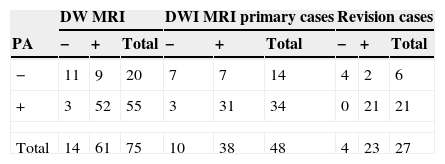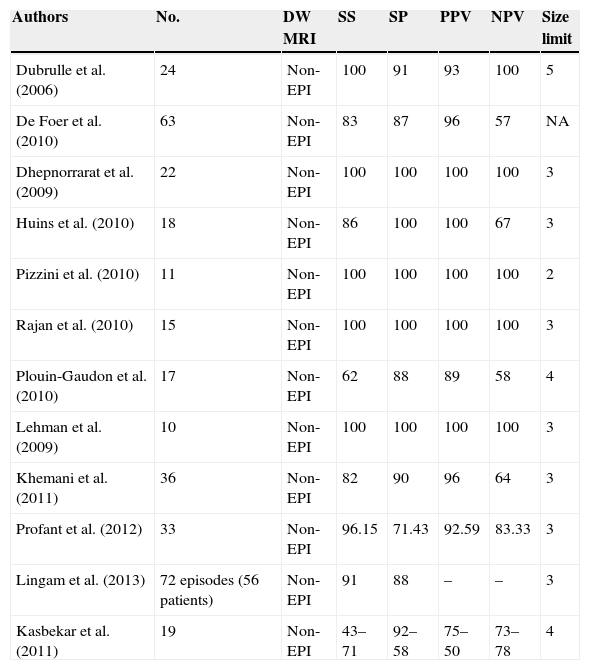the aim of this study was to determine the certainty of non-echo-planar imaging diffusion-weighted magnetic resonance imaging (non-EPI DW MRI) in the diagnosis of primary and recurrent cholesteatoma in patients with clinical suspicion of cholesteatoma, assessing the sensitivity and specificity of the test in both groups.
MethodsSeventy-five patients with clinical suspicion of cholesteatoma were included in our study. Forty-eight cases had primary suspicion of cholesteatoma and 27 cases had recurrent suspicion of cholesteatoma. All patients received non-EPI DW MRI tests before surgery, and radiological and surgical findings were compared.
ResultsSensitivity, specificity and the positive and negative predictive value for primary diagnosis of cholesteatoma group were 91.2%, 50%, 81.6% and 70%, respectively. For the recurrent cholesteatoma group these results were 100%, 66.7%, 90.9% and 100%, respectively.
ConclusionNon-echo-planar imaging diffusion-weighted magnetic resonance imaging is a high sensitivity imaging test for detecting cholesteatoma, for both primary diagnosis and for recurrent cases.
El objetivo de este estudio es determinar la fiabilidad de la resonancia magnética con técnica de difusión no eco-planar en el diagnóstico de pacientes con sospecha clínica de colesteatoma primario y recurrente, evaluando la sensibilidad y especificidad de la prueba en ambos grupos.
Métodos75 pacientes con sospecha clínica de colesteatoma fueron incluidos en el estudio. 48 pacientes presentaban sospecha clínica de colesteatoma primario y 27 pacientes presentaban sospecha clínica de colesteatoma recurrente. En todos los pacientes se realizó una resonancia magnética con técnica de difusión no eco-planar previa a la cirugía, y se compararon los resultados radiológicos con los resultados quirúrgicos obtenidos.
ResultadosLa sensibilidad, especificidad, valor predictivo positivo y negativo en el grupo de colesteatoma primario fue del 91,2%, 50%, 81,6% y 70% respectivamente y en el grupo de colesteatoma recurrente fue del 100%, 66,7%, 90,9% y 100%, respectivamente.
ConclusiónLa RM con técnica de difusión no eco-planar es una prueba altamente sensible en el diagnóstico del colesteatoma tanto en pacientes con colesteatoma primario como en recurrencias.







